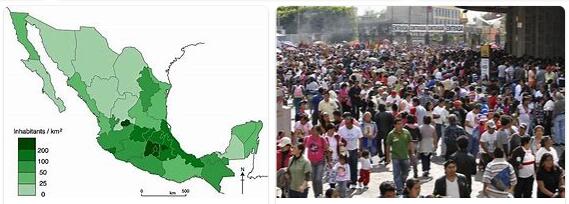Throughout the entire 19th century, Mexico’s population had barely doubled. This trend continued during the first two decades of the twentieth century, and even in the 1920 census a loss of about 2 million residents was recorded. The phenomenon can be explained because during the decade from 1910 to 1920 the Mexican Revolution took place.
The growth rate increased dramatically between the 1930s and 1980s, when the country registered growth rates of more than 3% (1950 -1980). The Mexican population doubled in twenty years, and at that rate it was expected that by the year 2000 there would be 120 million Mexicans. Faced with this situation, the federal government created the National Population Council (CONAPO), with the mission of establishing birth control policies and conducting research on the country’s population. The measures were successful, and the growth rate fell to 1.6 in the period from 1995 to 2000.
The last official national census published in 2005 counted 103 million residents [19] . The bulk of the population pyramid is located between 0 – 35 years, so the median age is 24 years. This young country has a life expectancy of 73 years for men and 78 years for women. The annual growth rate of the population is 1% and the crude birth rate is 19%.
The United States is the country where more Mexicans live after Mexico, some of the Mexicans in that country are of indigenous origin because they find better opportunities than in rural areas of Mexico. The Mexican presence in the northern neighbor begins with the annexation of the northern half of the country’s territory in 1847. Some of the Mexicans who remained on the other side of the border returned to Mexico, but others stayed there (this occurred mainly in Nuevo Mexico), and preserved their language and customs. They were joined by a good number of braceros, who went to settle in the United States, some temporarily, through a labor agreement between the governments of Washington and Mexico.
88% of the Mexican population declares itself Catholic. And 68% of Mexican households are made up of the nuclear family of parents and children. 90% of the population over 15 years of age is literate, with an equal participation of men and women. Mexico is known for registering high emigration to its northern neighbor, the United States, however, the immigration of foreigners to the country is less than 1%. Likewise, urban concentration is very high, 76% of the population resides in the country’s cities, particularly 20% of the total population resides in Mexico City, the capital [19] .
Ethnic groups
According to Programingplease.com, Mexico is ethnically diverse. Article 2 of the Mexican Constitution defines the country as:
The Nation has a multicultural composition originally based on its indigenous peoples, who are those who descend from populations that inhabited the current territory of the country at the beginning of colonization and who retain their own social, economic, cultural and political institutions, or part of them. [twenty]
Today’s Mexico is characterized by being a “mestizo nation”, or as José Vasconcelos Calderón (1925) put it, a “melting pot of all races” both culturally and racially. The historical discrimination of indigenous peoples and the fact that their living conditions are marked by poverty and discrimination has led to continuous struggles for their rights that are far from being a resolved issue.
Although there are no official statistics for the country’s ethnic identity, a high percentage of the population is phenotypically mestizo.
The language criterion has been used to determine the number of indigenous people in the country. However, this has been criticized, since ethnic identity is not given only by linguistic identity.
The figures offered by the National Institute of Geography, Statistics and Informatics and the National Commission for the Development of Indigenous Peoples (formerly the National Indigenous Institute, INI) are divergent. For the first, the indigenous population is around 6% of the total, while for the INI, the proportion ranges between 10 and 14%. On the CNDI website, the figure provided by the institution is 10,220,000 indigenous people in the country in 2000, which would constitute about 11% of the Mexican population. The criteria used by the CNDI for its calculation include, in addition to the linguistic, the place of origin, the ethnic identity of one or both parents, the individual assumption of indigenous identity, among others.
The CNDI only recognizes 65 indigenous ethnic groups distinguished from each other on the basis of linguistic criteria. The largest are the Nahuatl, the Mayan, the Zapotec, the Mixtec, the Otomí and the Purepecha. They are all descendants of the ancient Mesoamerican peoples. The smallest groups are the Kiliwa, settled in northern Baja California, and the Lacandon from Chiapas, with just a few dozen members.
Regarding immigration to Mexico, the main foreign communities with a strong presence in Mexican territory are the American communities, followed by Spanish, Guatemalan, Argentine, Colombian, Honduran, German, Italian, Cuban, Salvadoran, French, Chinese, Russian, and Canadian communities., Lebanese, Jewish, Gypsy, Japanese, Uruguayan, Peruvian and Korean.
